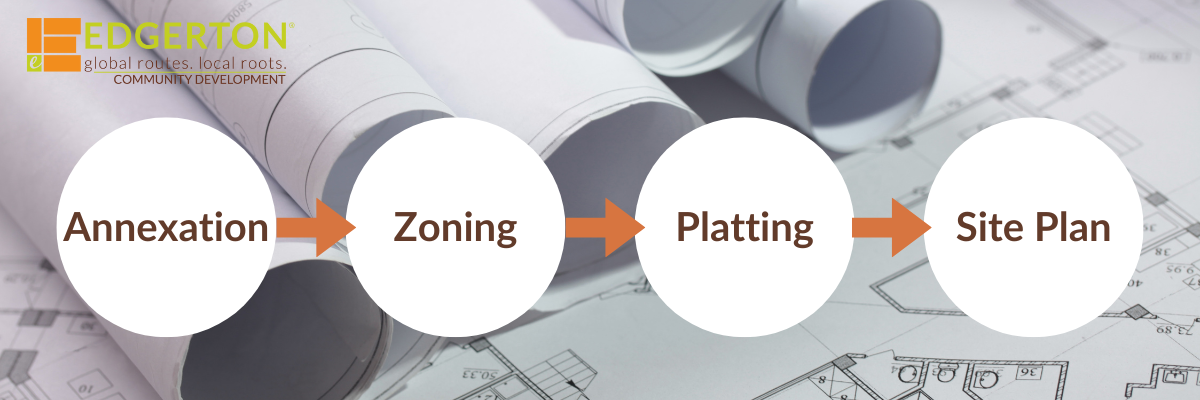
The City of Edgerton would like to assist you with any development proposals you may have for your property within the corporate limits of the City. The development process can be difficult to understand, so the City has prepared this section of the website to help you better understand what will be required for various processes, the time that will be required, and any fees that you will incur as a result of your development progressing through each process.
Staff is also available to assist you with any questions you may have regarding the development process. Please feel free to call (913) 893-6231 for more information or if you have questions regarding the City's development processes.
What is annexation?
Annexation sounds like a complicated, technical term, but its meaning is quite simple. Annexation is the process by which a city adds land to its jurisdiction in order to extend its services, laws, and voting privileges to residents living in the annexed area.
Why does Edgerton annex land?
Typically a property owner requests to be annexed into Edgerton so that the City can provide water, sewer or other city services to new developments. Bringing your property inside the City limits allows for simplified boundaries, better planning and development and makes it easier to provide services in an efficient, affordable manner.
Types of Annexations
There are basically two types of annexation: consent and unilateral annexation.
Consent annexation is the most common type of annexation and occurs when a property owner requests to be annexed into the city limits. There are two types of consent annexation: contiguous and island.
Contiguous simply means adjoining or touching a current city boundary. Under K.S.A. 12-520 (a)(7), property that adjoins the existing corporate limits of the City may request to be annexed by the owner signing a consent annexation form and filing it with the City Clerk. The City Council will then review and consider the contiguous consent annexation. The City Council can approve the annexation with the passage of an ordinance which becomes effective upon its publication in the official City newspaper. No notification of neighbors is required and there is no public hearing requirement.
Contiguous consent annexation as described above is the most efficient method of being annexed by the City. The items necessary for a consent annexation include a contiguous boundary with the existing City limits, a consent to annex form filed with the City Clerk and a legal description for the property to be considered for annexation.
Property that does not touch the City boundaries is considered an “island annexation” and requires certain approvals from both the City of Edgerton City Council and the Johnson County Board of County Commissioners, which will increase the time required for the annexation proceeding. To the extent possible, the City would like to avoid “island” annexations unless a greater public good is served in proceeding with such an annexation.
Unilateral annexations occur when a City wishes to annex land without the prior permission of the property owner. State law outlines the criteria for unilateral annexation by a municipality and specifies the annexation procedures that must be followed. This includes notification of affected property owners, at least one public hearing, and the preparation of a municipal services plan. Mayor Roberts and the Edgerton City Council have repeatedly expressed their disinterest in unilateral annexations.
At the end of each year, the City Council must pass a resolution declaring the corporate boundaries of the City in any properties were annexed into the City. This step is more of a formality and property owners have no responsibility in fulfilling this requirement.
Zoning laws regulate the use of land on a property by dictating what uses are permitted and what uses are prohibited. The City of Edgerton has adopted a Unified Development Code to encourage the most appropriate use of land to to insure the logical and compatible growth of the various districts within the City.
Property owners requesting rezoning should file all necessary materials at least 35 days prior to a regularly scheduled Planning Commission meeting.
The applicant will be responsible for mailing notices of the public hearing for the requested rezoning by certified mail, return receipt requested to all owners of land within the notification area: two hundred (200) feet within the city limits; one thousand (1,000) feet in the unincorporated area of the subject property. These notices must be sent a minimum of twenty (20) days prior to the public hearing. In addition, the City will publish a public hearing notice in the official city newspaper and post a sign at the property. The Planning Commission and Governing Body shall determine whether the amendment is found to be generally compatible with surrounding development and is in the best interest of the City.
Conditional Use Permits
Certain uses of land, buildings or structures may not be appropriate under all circumstances in any given zoning district but may be appropriate where additional reviews and requirements can assure compatibility with surrounding uses and developments. See Article 7 of the UDC for details.
Typically property is platted prior to the issuance of any building permit. Platting involves the subdivision of land into lots or tracts. It allows for larger tracts to be phased in the development. A plat is prepared only by a licensed engineer or surveyor, and is recorded as a permanent legal document that includes an accurate description and a graphical depiction of any real property that is to be divided. The intent of platting is to provide a readily accessible and easily understandable public record of property. Units of property that have been created by platting can be easily transferred between interested parties.
Preliminary Plats
Preliminary plats demonstrate an overall subdivision concept for an entire ownership tract. The preliminary plat indicates the general lot configuration, street layout, and existing topography. Preliminary plat applications shall be submitted at least forty-nine (49) days prior to a scheduled meeting of the Edgerton Planning Commission. The Edgerton Planning Commission will consider the Preliminary Plat during a public hearing held a regularly scheduled Planning Commission meeting. The City is required to publish notice of the public hearing at least twenty (20) days prior to the hearing in the official City newspaper. The Planning Commission shall review the Preliminary plat and other material submitted with it to determine conformity with the comprehensive plan and these regulations. The Planning Commission shall act upon the plat within ninety (90) days after submission, unless the sub-divider shall waive or consent to an extension of the ninety (90) day period. If the sub-divider submits the preliminary and final plats concurrently, the time period shall be ninety (90) days.
Final Plats
Final plats generally represent only one phase of development within an approved preliminary plat. The plat must conform to the approved preliminary plat, but it is far more detailed than the preliminary, including exact easement locations and dedication language for all public purposes.
Final plat applications shall be submitted at least forty-nine (49) days prior to a scheduled meeting. If the final plat complies with the preliminary plat, Planning Commission and Governing Body may consider approval without notice or public hearing. The City Council considers acceptance of any public rights-of-way or other property proposed to be dedicated to the City as indicated on the Final Plat. Property owners and City officials sign an approved Final Plat drawing that must be recorded by the Johnson County Register of Deeds. An excise tax, based on the total land area of the Final Plat is required to be paid to the City prior to release of the plat for recording at the County.
For additional information and a checklist of items to include with the preliminary and final plats, please see the applications.
Site plans are detailed, scale drawings showing the proposed development of a specified parcel of land, including the location and design of buildings, easements, utility layouts, parking arrangements, public access, street patterns, drainage controls, existing vegetation and natural features, landscaping, lighting and other similar features.
The Planning Commission reviews the site plans to determine if they demonstrate a satisfactory quality of design in the individual buildings and the site, the appropriateness of the building or buildings to the intended use, and the aesthetic appropriateness of the development to its surroundings.
For specific details regarding site plan requirements for Logistics Park Zoning, please see Article 5, Section 5.2 of the Unified Development Code.
Site plan review may be completed simultaneously with the platting process if preferred.








